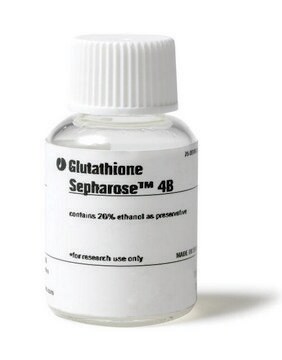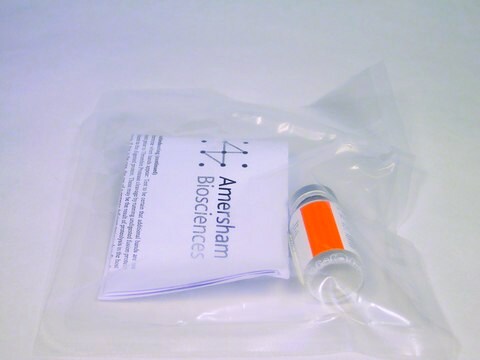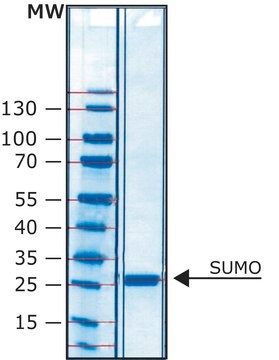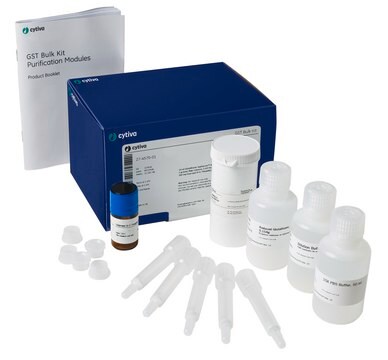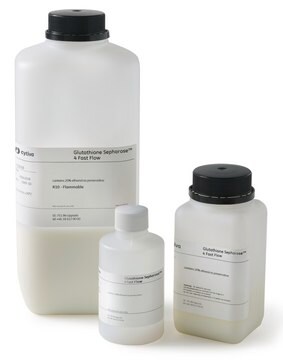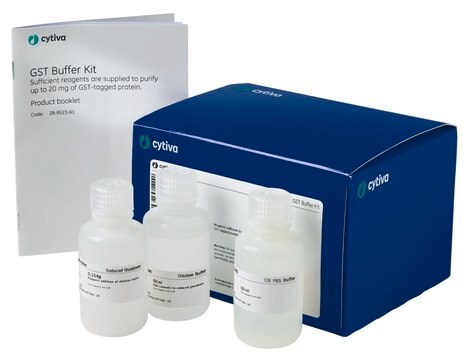GE27-0843-01
PreScission Protease
Cytiva 27-0843-01
Synonym(s):
fusion protein, GST-tag removal
About This Item
Recommended Products
packaging
pkg of 500 units
manufacturer/tradename
Cytiva 27-0843-01
shipped in
dry ice
storage temp.
−70°C
Related Categories
General description
On-column or off-column enzyme cleavage
GST tags and protease can be removed in a single step while fusion proteins are still bound to Glutathione Sepharose 4B, Glutathione Sepharose High Performance, or Glutathione Sepharose 4 Fast Flow affinity resin. Another option is to elute the GST-tagged protein using reduced glutathione, cleave, then pass the sample over the same resin to remove the protease and tags. Unlike other common proteases, such as thrombin and Factor Xa, this GST-tagged fusion protein can be removed easily through binding to a resin with affinity for GST. Other non-recombinant proteases require an additional purification step with a different resin.
Vectors encoding the HRV 3C protease recognition sequence
pGEX-6P vectors pGEX-6P-1, pGEX-6P-2, and pGEX-6P-3 encode the recognition sequence for this 3C protease.
Application
PreScission Protease has been used for eluting GST-tagged AT3, during in vitro ubiquitination reactions and AT3-Ub preparation. It has also been used to cleave GST tag from the a-enolase during induction of GST a-enolase expression in the protease-deficient BL21 strain of Escherichia coli.
Features and Benefits
- Specific cleavage – between the Gln and Gly residues of the recognition sequence LeuGluValLeuPheGln/GlyPro.
- Time-saving – GST-tagged proteins can be cleaved while still bound to an affinity resin.
- Low incubation temperature – enables low temperature cleavage of fusion proteins containing the HRV 3C protease recognition sequence.
Storage and Stability
Analysis Note
Legal Information
pGEX Vectors are to be used for scientific investigation and research and for no other purpose whatsoever and a license for commercial use of the licensed products and the processes claimed in US patent 5,654,176 and equivalent patents and patent applications in other countries must be negotiated directly with Millipore Corp (formerly Chemicon International Inc) by the purchaser prior to such use.
Storage Class
12 - Non Combustible Liquids
wgk_germany
WGK 1
flash_point_f
Not applicable
flash_point_c
Not applicable
Certificates of Analysis (COA)
Search for Certificates of Analysis (COA) by entering the products Lot/Batch Number. Lot and Batch Numbers can be found on a product’s label following the words ‘Lot’ or ‘Batch’.
Already Own This Product?
Find documentation for the products that you have recently purchased in the Document Library.
Customers Also Viewed
Articles
This page describes troubleshooting strategies for cloning the gene or gene fragment into a pGEX expression vector.
This page shows troubleshooting strategies for cleavage methods using Cytiva products.
This page shows how to cleave and purify GST-tagged proteins bound to Glutathione Sepharose in batch mode from Cytiva. Glutathione Sepharose High Performance, Glutathione Sepharose 4 Fast Flow, and Glutathione Sepharose 4B can all be used for cleavage and purification of GST-tagged proteins in batch.
This page shows how to cleave and purify GST-tagged proteins bound to GSTrap from Cytiva.
Protocols
To protect the fusion protein from proteolytic degradation prior to enzymatic cleavage with PreScission Protease, thrombin, or Factor Xa, it may be necessary to remove proteases from the sample. Additionally, following enzymatic cleavage, it may be necessary to remove thrombin or Factor Xa from the sample.
Our team of scientists has experience in all areas of research including Life Science, Material Science, Chemical Synthesis, Chromatography, Analytical and many others.
Contact Technical Service
